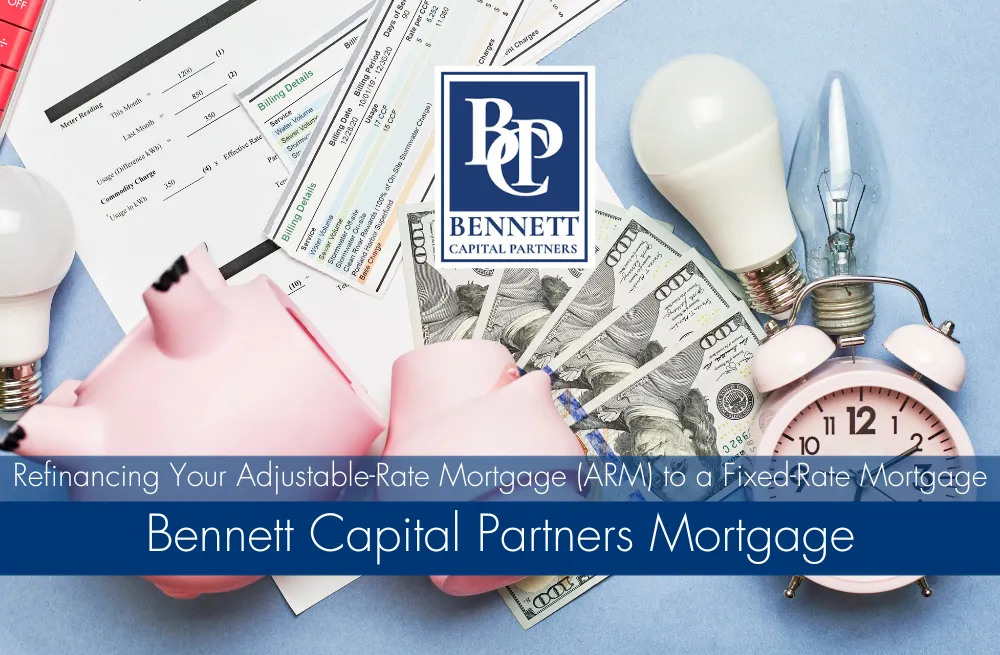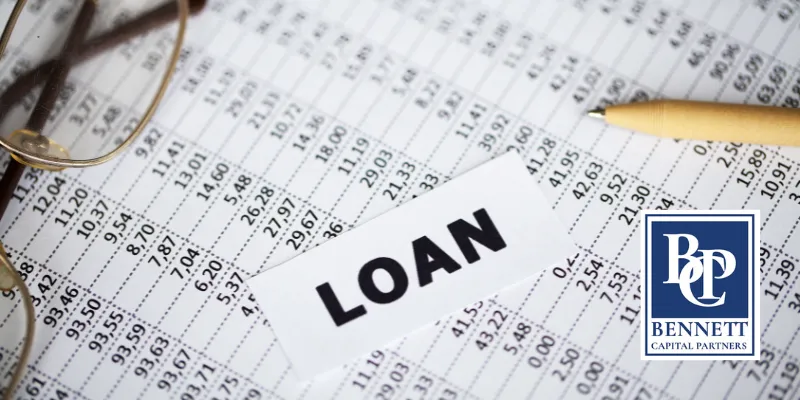Refinance from ARM to Fixed Rate: Top Benefits
Updated: Jan 3

Homeowners with adjustable-rate mortgages (ARMs) often face financial uncertainty due to fluctuating interest rates. Refinancing to a fixed-rate mortgage can provide long-term financial stability by securing predictable monthly payments. This article explores the reasons and process behind refinancing from an ARM to a fixed-rate mortgage, helping readers determine if this option is suitable for their circumstances and offering practical guidance for a successful transition.
Quick Navigation - Click the link below to jump to that section..
Reasons To Refinance From An Arm To A Fixed-Rate Mortgage

Refinancing an adjustable-rate mortgage (ARM) to a fixed-rate mortgage (FRM) can offer several benefits, including more predictable monthly payments and the potential to save money over the life of the loan.
The process of refinancing can involve a number of steps, including researching lenders, comparing offers, and understanding the long-term financial implications of the loan.
Refinancing to a fixed-rate mortgage can provide homeowners with greater certainty, as the interest rate will remain the same for the entire duration of the loan.
Those considering refinancing should weigh their options carefully and consider the costs associated with the process, as they may outweigh the potential benefits of refinancing.
Benefits Of Refinancing
The anxiety and uncertainty that comes with an adjustable-rate mortgage (ARM) can be overwhelming for many homeowners. Refinancing to a fixed-rate mortgage offers the peace of mind that only financial stability and predictability can provide.
The benefits of refinancing from an ARM to a fixed-rate mortgage are numerous, including more predictable monthly payments, protection against rising interest rates, and long-term financial planning.
One significant advantage of refinancing from an ARM to a fixed-rate mortgage is the ability to secure a stable monthly payment throughout the life of the loan. By locking in a consistent interest rate, homeowners no longer need to worry about fluctuating mortgage rates affecting their monthly expenses.
This allows for better budgeting and ease in managing personal finances without the stress of potentially skyrocketing home loan costs due to market volatility.
Furthermore, as interest rates rise over time, those who have chosen to refinance into a fixed-rate mortgage will find solace in knowing that they are protected against these increases.
In addition to mitigating potential risks associated with unpredictable interest rates, mortgage refinancing also facilitates long-term financial planning by providing consistency in principal and interest payments. Homeowners may utilize this newfound stability when making crucial investment decisions or contemplating retirement plans since they can now rely on set housing costs each month.
Moreover, depending on individual circumstances and current market conditions, some borrowers might even obtain lower overall payments through refinancing – further solidifying their decision to transition from an adjustable-rate mortgage to its fixed counterpart.
In essence, embarking upon a mortgage refinance not only alleviates immediate concerns surrounding variable ARM but also paves the way for sound fiscal management well into the future.
Steps To Refinance
Transitioning from an adjustable-rate mortgage to a fixed-rate mortgage can provide numerous benefits such as stability in monthly payments, protection against rising interest rates, and long-term financial planning. To capitalize on these advantages and successfully refinance one's home loan, certain steps must be followed diligently.
By understanding the refinancing process, homeowners can make informed decisions that will ultimately lead to improved financial security and peace of mind.
The first step in the refinancing process is for homeowners to assess their current mortgage terms and overall financial situation. This includes evaluating the remaining balance on the adjustable-rate mortgage, time left until its scheduled adjustment, and any potential prepayment penalties associated with early termination.
Additionally, it is crucial to consider credit scores, debt-to-income ratios, and available equity in determining eligibility for favorable refinancing options. Once a comprehensive overview of personal finances is obtained, borrowers should research prevailing market conditions and compare various fixed-rate mortgage offers from multiple lenders – taking note of differences in interest rates, closing costs, and repayment terms.
Upon selecting a suitable lender offering competitive fixed-rate mortgage terms aligned with individual needs and goals, homeowners must then submit all required documentation necessary for loan approval. This typically entails gathering proof of income statements, tax returns, bank account information, property appraisals or assessments corroborating sufficient equity levels within the home.
With due diligence throughout each stage of this complex yet rewarding endeavor to refinance into a more stable housing payment structure; borrowers reap lasting rewards by securing predictable monthly expenses while insulating themselves from future fluctuations within broader economic environments.
When And How To Refinance Your Arm

When considering the timing of a refinance, it is important to evaluate the current market and look for advantageous terms.
Additionally, researching the current mortgage rate and comparing it to the rate of the existing loan can be beneficial in determining the best time to refinance.
When evaluating finances for a refinance, a borrower should consider their current credit score, debt-to-income ratio, and the cost of closing.
Furthermore, the borrower should take into account the type of loan they currently have and the amount of time they plan to stay in the home in order to make the best decision for their situation.
Timing The Market
Refinancing an adjustable-rate mortgage (ARM) to a fixed-rate mortgage is a strategic decision that requires careful consideration of market conditions and personal financial goals.
One crucial aspect in this process involves timing the market, which refers to making well-informed predictions about future interest rate trends based on current economic indicators. By doing so, borrowers can capitalize on favorable circumstances by locking into lower rates for their new fixed-rate loans.
Market timing plays a significant role in determining whether or not it is advantageous to refinance an ARM into a fixed-rate mortgage.
For instance, if prevailing interest rates are expected to rise significantly over time, it may be wise for homeowners with ARMs to consider refinancing sooner rather than later.
However, if mortgage rates are projected to remain stable or even decline in the near term, waiting before refinancing might present better opportunities down the road. It is essential for potential refinancers to keep abreast of macroeconomic factors that could influence these fluctuations, such as inflationary pressures and central bank policies.
In summary, timing the market when considering the switch from an adjustable-rate mortgage to a fixed-rate one is crucial in order to maximize savings and achieve long-term financial stability. A keen understanding of interest rate movements will enable homeowners with ARMs to make informed decisions regarding when best to pursue refinancing options.
This knowledge equips them with valuable insight into how they can effectively navigate changing loan landscapes and secure optimal terms for their new mortgages.
Evaluating Finances
In addition to timing the market, evaluating finances is an equally important aspect when considering refinancing an adjustable-rate mortgage into a fixed-rate mortgage.
A thorough assessment of one's financial situation and goals allows homeowners with ARMs to determine whether they can afford the costs associated with refinancing and if it aligns with their long-term objectives.
This process involves analyzing income stability, credit scores, accumulated debts, savings, and other relevant factors that may impact a borrower's ability to secure favorable loan terms.
Mortgage rates are only one component of the broader decision-making process when contemplating a mortgage refinance.
Homeowners should also weigh the potential benefits against any drawbacks related to switching from an ARM to a fixed-rate home loan.
These considerations include possible lower monthly payments, increased predictability in budgeting due to stable interest rates, protection from future rate hikes, as well as accounting for closing costs and fees inherent in obtaining a new mortgage.
By carefully evaluating finances before pursuing refinancing options, borrowers can make more informed decisions on how best to proceed in transitioning from an adjustable-rate mortgage to a fixed-rate one.
Such careful analysis will ensure that individuals maximize their financial gains while minimizing risks associated with changing loan structures.
Costs And Considerations Of Refinancing

Closing costs are an important factor to consider when refinancing a loan, and can include fees such as origination and appraisal fees.
Depending on the situation, the cost of closing can be rolled into the refinanced loan or paid upfront.
An extended loan term is also a consideration when refinancing; as the loan term increases, so does the total amount of interest paid over the life of the loan.
It is important to weigh the potential savings of refinancing with the associated costs and extended loan term, to determine if the refinancing process is the right decision.
Closing Costs
Refinancing an adjustable-rate mortgage (ARM) to a fixed-rate mortgage can provide homeowners with stability and predictability. However, before jumping into the process, it is essential to understand that refinancing comes with closing costs. These expenses are fees paid at the end of the transaction when transferring ownership or obtaining new financing.
When considering refinancing from an ARM to a fixed-rate mortgage, it is crucial to weigh the potential savings against these closing costs. Generally, these fees range between 2% and 5% of the home loan amount and might include appraisal fees, title search fees, recording fees, underwriting fees, and other third-party charges.
To determine if refinancing makes financial sense for a homeowner's specific situation, using a refinance calculator may be beneficial in evaluating various scenarios by comparing current mortgage rates, proposed refinance rates, and estimated closing costs.
Another factor to consider is whether there is enough equity built up within the property for refinancing. Home equity loans often have lower closing costs compared to traditional mortgages since they require fewer steps during processing. Additionally, some lenders offer no-cost or low-cost refinances which waive or reduce certain closing costs; however, this option typically leads to higher interest rates on the new loan.
Therefore, carefully assessing all available options becomes paramount in making an informed decision about whether refinancing an adjustable-rate mortgage into a fixed-rate mortgage proves advantageous financially in both short- and long-term perspectives.
Extended Loan Term
In addition to closing costs, another critical factor to evaluate when considering a refinance from an adjustable-rate mortgage to a fixed-rate mortgage is the potential for an extended loan term. Refinancing often involves obtaining a new home loan with different terms and conditions than the existing mortgage.
As a result, homeowners may inadvertently extend their repayment period by choosing a longer-term for their new fixed-rate mortgage than what was remaining on their ARM. While extending the loan term might provide lower monthly payments in some cases, it could lead to increased overall interest expenses throughout the life of the loan.
Homeowners must assess whether this trade-off aligns with their financial objectives before committing to refinancing. Comparing various scenarios using mortgage calculators or consulting with experienced professionals can help determine if converting from an ARM to a fixed-rate mortgage offers long-term benefits despite potentially higher interest rates over time due to an extended loan term.
In conclusion, navigating the complexities associated with refinancing requires careful consideration of multiple factors such as closing costs, equity position, available options offered by lenders, and potential changes in loan terms that may affect overall financial outcomes. By evaluating these aspects diligently and seeking professional guidance as needed, homeowners can make informed decisions about whether transitioning from an adjustable-rate mortgage into a fixed-rate mortgage proves advantageous for their unique circumstances.
Alternatives To Refinancing Your Arm

Undoubtedly, refinancing an adjustable-rate mortgage (ARM) to a fixed-rate mortgage offers numerous benefits; however, it is crucial for homeowners to explore other alternatives before making this decision.
With that in mind, some viable options do not involve refinance and may prove beneficial depending on individual circumstances.
One such alternative to refinancing an ARM is recasting the mortgage. This process involves paying a lump sum towards the principal balance and subsequently recalculating the monthly payments based on the new lower balance while maintaining the original loan term and interest rate structure.
Recasting can be advantageous as it allows borrowers to reduce their monthly payments without going through the entire process of obtaining a new home equity loan or refinance mortgage. Moreover, this option may provide financial relief at times when mortgage rates are high or unfavorable for refinancing.
Another approach worth considering is making extra payments toward one's existing adjustable-rate mortgage. By allocating additional funds towards reducing the outstanding principal amount, homeowners can accelerate amortization and potentially shorten their loan term.
Consequently, this strategy results in reduced overall interest expenses over time – despite fluctuations in ARM rates – while also increasing home equity faster than scheduled payments alone would allow. Thus, exploring these alternatives empowers individuals with valuable knowledge essential for informed decisions regarding their mortgages' future trajectory without necessarily committing to full-scale refinancing endeavors.
Conclusion

In conclusion, refinancing an adjustable-rate mortgage to a fixed-rate mortgage can provide homeowners with the stability of predictable monthly payments and protection from potential interest rate increases.
This financial strategy may be particularly beneficial for those who plan to stay in their homes long-term or are concerned about uncertain economic conditions.
However, it is essential to weigh the costs and benefits of refinancing carefully, as well as consider alternatives such as loan modification programs.
Ultimately, each homeowner's unique circumstances will determine whether this option is appropriate for achieving greater control over personal finances and promoting long-term financial security.
FAQ's
What are the main benefits of refinancing from an ARM to a fixed-rate mortgage?
Refinancing from an ARM to a fixed-rate mortgage can provide several benefits, including long-term financial stability, predictable monthly payments, and protection from rising interest rates. By switching to a fixed-rate mortgage, homeowners can eliminate the uncertainty associated with fluctuating interest rates, which can help them better manage their budget and financial planning.
When is the best time to consider refinancing from an ARM to a fixed-rate mortgage?
The best time to consider refinancing from an ARM to a fixed-rate mortgage is when interest rates are low or expected to rise, and the homeowner has a stable income and a good credit score. Additionally, if the initial fixed-rate period of the ARM is about to end, and the interest rate is expected to adjust upwards, refinancing to a fixed-rate mortgage can help avoid potentially higher monthly payments.
How does the refinancing process work when switching from an ARM to a fixed-rate mortgage?
The refinancing process involves applying for a new fixed-rate mortgage, which will replace the existing ARM. Homeowners will need to provide financial documentation, such as proof of income and credit history, and obtain a property appraisal. Once approved, they will work with their lender to close on the new mortgage, which will involve paying closing costs and signing new loan documents.
Are there any drawbacks to refinancing from an ARM to a fixed-rate mortgage?
There can be some drawbacks to refinancing from an ARM to a fixed-rate mortgage, such as higher closing costs, a potentially longer loan term, and the possibility of a higher interest rate compared to the initial rate of the ARM. However, these drawbacks may be offset by the long-term stability and predictability of fixed monthly payments.
What are some alternatives to refinancing from an ARM to a fixed-rate mortgage?
Alternatives to refinancing from an ARM to a fixed-rate mortgage include refinancing to another ARM with better terms, modifying the existing ARM through a loan modification program, or simply waiting until the interest rate adjusts and reassessing the situation. Homeowners should carefully evaluate their financial situation and future goals before deciding which option is best for them.
Related Articles in Our Refinancing Blog Posts
Looking for more information on refinancing your mortgage? Check out these informative articles;
Cash-Out Refinancing Vs. Rate-And-Term Refinancing: Which One Is Right For You? - Learn about the differences between these two types of refinancing and which one may be the best fit for your financial situation.
How To Calculate Your Break-Even Point For Refinancing: A Step-By-Step Guide - This comprehensive guide will walk you through the process of determining your break-even point for refinancing, helping you make an informed decision.
Mortgage Refinancing For Home Improvements: Unlocking Your Home's Equity For Renovations - Discover how refinancing your mortgage can help you fund home improvement projects and increase the value of your property.
Refinancing Your Adjustable-Rate Mortgage (ARM) To A Fixed-Rate Mortgage: Why And How To Do It - Considering making the switch from an adjustable-rate mortgage to a fixed-rate mortgage? Learn about the benefits and how to do it in this helpful article.
Mortgage Refinancing in Florida: The Ultimate Guide to Lowering Your Monthly Payments & Saving Money - Learn about the benefits of mortgage refinancing in Florida, eligibility requirements, costs, and more in this ultimate guide.
Streamline Refinancing: A Simplified Process For FHA, VA, And USDA Loans - Find out how to simplify the refinancing process for FHA, VA, and USDA loans.
The Costs Of Refinancing: Understanding Closing Costs, Fees, And Potential Savings - Get a breakdown of the costs and fees associated with refinancing, as well as potential savings.

Philip Bennett
Philip is the owner and Licensed Mortgage Broker at Bennett Capital Partners, Bus. NMLS # 2046828. He earned his degree in Accounting and Finance from Binghamton University and holds a Master's Degree in Finance from NOVA Southeastern University. With more than 20 years of experience, Philip has been a leader in the mortgage industry. He has personally originated over $2 billion in residential and commercial mortgages.
Learn more about Philip Bennett's background and experience on our Founder's page. Whether you're a first-time homebuyer or a seasoned real estate investor, our team is here to help you achieve your real estate goals. Don't wait any longer, contact us today and let us help you find the right mortgage for your needs.
Discover helpful tips and tricks on mortgages by reading our blog posts
Understanding Co-op Financing: Mortgages For Co-ops Explained. To learn more about how this program can help you purchase your Co-op. Click here to read the full article
Mortgage Solutions for Newly Employed Individuals: Exploring Job Offer Loans. To learn more about how this program can help you purchase your dream. Click here to read the full article
DSCR loan program: debt service coverage ratio mortgage | Bennett Capital Partner To learn more about how the DSCR loan program can help you with your investment objectives. Click here to read the full article
Can You Still Get a No-Doc Mortgage in 2023? To learn more about how this program can help you get your dream mortgage. Click here to read the full article
How to Get Foreclosure Bailout Mortgages: A Step-by-Step Guide. To learn more about how this program can help you with a foreclosure bailout. Click here to read the full article
How to Qualify for an FHA Loan in Miami: The Complete Guide. To learn what the FHA loan limits are. Click here to read the full article.
Can I Get a Bank Statement Cash Out Refinance Loan? To learn more about how this program can help you get cash out of your home. Click here to read the full article
